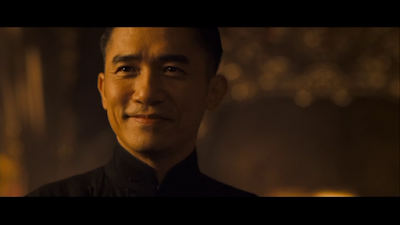
Ever since I learned that the international/U.S. release of The Grandmaster is significantly shorter than the version that was released in Hong Kong, I’ve wanted to see the original cut of the film. Years ago, I read a review comparing the two versions, and the writer maintained that the original cut was the superior one, but that the U.S. version could function as a “codex” to better understand the denser, more complex Chinese cut.
I knew I wanted to see the Chinese cut, but I didn’t know how to find it. I consulted Ebay, my go-to spot for Tony Leung Chiu-wai movies I can’t get in the U.S., but sellers didn’t appear to label which version of the film they had, and I didn’t want to spend money on a second copy only to get it and discover it was the same version I already owned. (Why didn’t I message sellers and ask them which cut they had? A valid question with an important, introvert-related answer.) Finally, though, I was turned onto a copy of the Chinese version of the film.
The Grandmaster follows Ip Man, the expert martial artist who went on to teach Bruce Lee. Not that the film focuses on Lee, instead exploring Ip’s life before, during, and after WWII. His craft comes of age in the 1930s, when kung fu in China divides along geographic lines. Ip is a southern artist, and the film is marked by his encounters with Gong Er, the daughter of the renowned northern grandmaster. Like all of Wong’s works, the story flows, river-like, between ideas, rather than following a more traditional three-act plot.
Though I’ve seen the U.S. cut of The Grandmaster multiple times, it’s probably been at least five years since I last watched it, so I couldn’t swear to what was a change between versions and what wasn’t—before writing this review, I went back to that old comparison article to refresh my memory. There were certain scenes that immediately stuck out as new to me. There are more scenes involving the Razor, the lethal martial artist played by Chang Chen, but as it happens, his single scene in the U.S. cut (where he comes up against Ip Man) isn’t in this version. We also get more about the Sino-Japanese War as it’s happening, such as scenes of Japanese flags hung in the brothel where the martial artists gather and seeing characters we know executed by Japanese soldiers.
Gong Er’s storyline is expanded, and this cut arranges her storyline to be happening more concurrently with Ip Man’s. In the U.S. cut, we primarily follow Ip Man, and when we catch up with Gong Er, the narrative doubles back on itself and we explore her history in the context of Ip Man learning about it. Here, we move between Gong Er in the north and Ip Man in the south (and later relocating to Hong Kong.) The thread of wistful longing between the two is also highlighted more. These differences make the film much more of a dual protagonist narrative, with more emphasis on the romantic aspects.
At the same time, we also get much more of Ip Man’s wife, a character who’s practically a background character in the U.S. cut. Even though only a few short scenes are added for her, they open up her character and her relationship with Ip Man in delicate, fascinating ways, which only makes Ip Man’s dynamics with Gong Er even more complex.
It’s interesting. On the whole, I’d say the Chinese cut of The Grandmaster makes for an even fuller, richer experience, one that feels more firmly grounded in Wong Kar-wai’s aesthetic and sensibilities. And yet, there’s very little extra material here for Leung as Ip Man. Some of his voiceover dialogue is different, and of the handful of added scenes for him, most of them focus primarily on character action and have little dialogue. For instance, there’s a scene of Ip Man breaking apart his wooden training post after the war hits and money is tight. Little things, and again, they add up to further flesh out his character, but there aren’t very many acting scenes that were left on the cutting room floor between versions. Which I suppose makes sense—I mean, if I had to cut 20 minutes out of a Tony Leung Chiu-wai movie for U.S. audiences, I’d cut as little of Leung’s performance as possible!
Recommend?
In General – If you can find it, I would. This version of the film is well worth seeing and does create a somewhat different viewing experience.
Tony Leung Chiu-wai – Sure (again, if you can find it.) Even though Leung’s scenes are probably more than 95% identical to the U.S. cut, I do like the little extra nuances brought out here.
Warnings
Tons
of sumptuous kung fu action, some smoking, brief drug use, and a little
swearing.
No comments:
Post a Comment